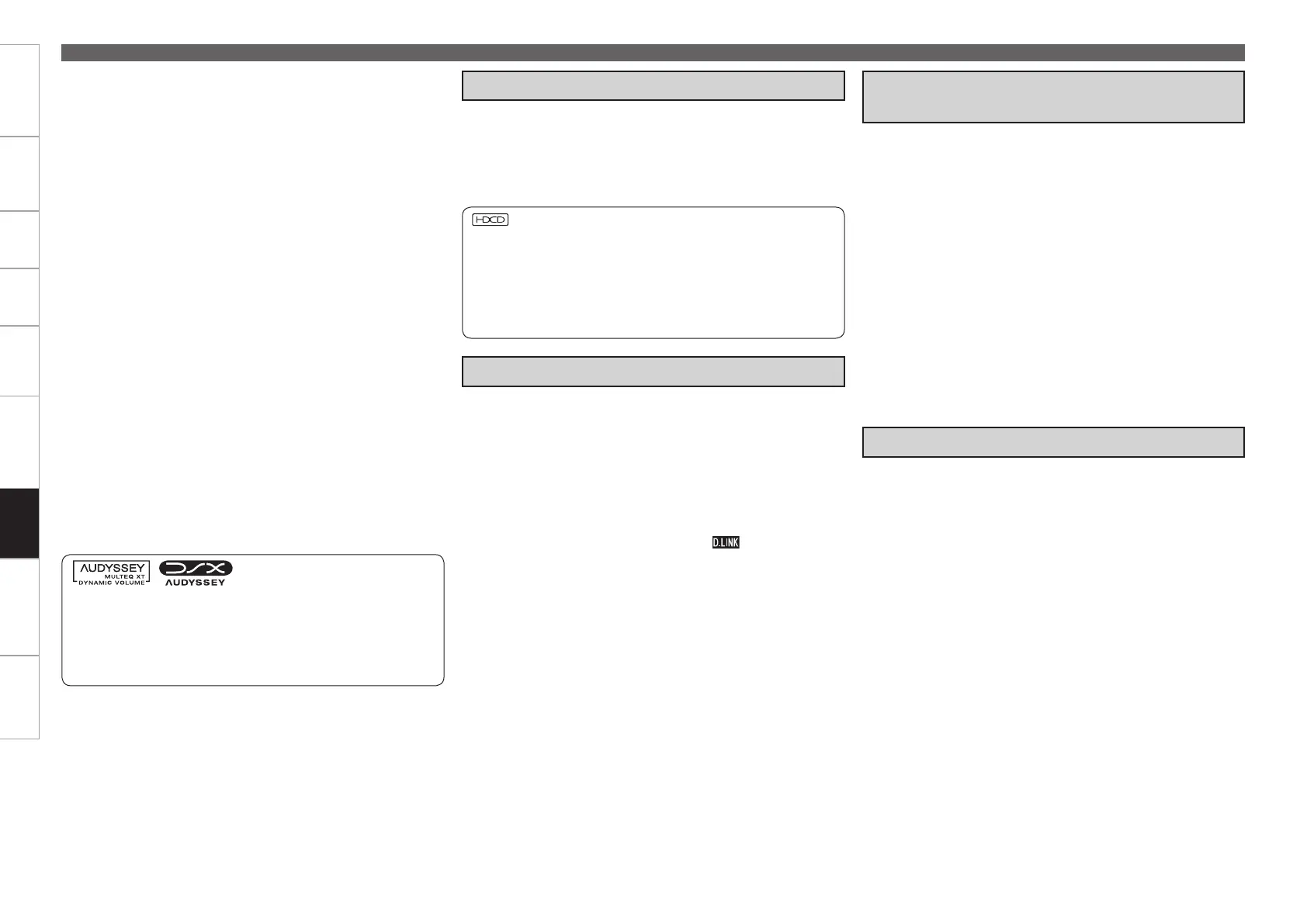Getting Started Connections Settings Playback Remote ControlMulti-zone Information Troubleshooting SpecificationsInformation
Explanation of Terms
Research in the perception of auditory source width has shown that
there are strong preferences in the direction of reflected sound and the
perception of soundstage width and spaciousness. The single most
important direction of side-wall reflections is ±60°. DSX provides a pair
of Wide channels (LW and RW) at ±60° with appropriate frequency
response and perceptual processing to match the requirements of
human hearing. In fact, the Wide channels are much more critical in
the presentation of a realistic soundstage than then Back Surround
channels found in traditional 7.1 systems. A more enveloping 7.1
channel system is one in which Wide speakers are used instead of
Back Surround speakers. Adding surround channels behind the listener
has a very small impact compared to the increase in envelopment and
soundstage width that the front wide channels will provide.
After side reflections, the next most important acoustical and
perceptual cues come from reflections above the front stage. DSX
provides a pair of Height channels (LH and RH) at a ±45° azimuth angle
and elevated to a 45° angle in the median plane.
In addition to creating new Wide and Height channels, DSX also
provides Surround Processing to enhance the envelopment of the
Surround and Back Surround channels (if present). DSX Surround
Processing processes the standard surround signals in the time and
frequency domains to improve the perceived sense of envelopment
and blending with the other speakers in the surround system.
Audyssey Dynamic Surround Expansion is a scalable system that can
adapt to the practical needs of the user. The first level of surround
stage enhancement comes from adding the Wide channels. The
second level comes from adding the Height channels. If it is practical
to have both Wides and Heights then the surround performance will
be further enhanced. DSX automatically reconfigures its processing
to optimize surround rendering over any number of available speakers
beyond 5.1.
Manufactured under license from Audyssey Laboratories. U.S. and
foreign patents pending. Audyssey MultEQ
®
XT is a registered
trademark of Audyssey Laboratories. Audyssey Dynamic EQ™ is a
trademark of Audyssey Laboratories. Audyssey Dynamic Volume™
is a trademark of Audyssey Laboratories. Audyssey Dynamic
Surround Expansion™ is a trademark of Audyssey Laboratories.
HDCD
®
HDCD
®
is an encoding/decoding technology that greatly reduces
the distortion that occurs upon digital recording while maintaining
compatibility with the conventional CD format, thus expanding the
dynamic range and achieving a high resolution.
Conventional CDs and HDCD compatible CDs are identified
automatically to select the optimum digital processing.
DENON LINK
DENON LINK is a unique digital, balanced transfer type interface
developed by DENON. It offers high speed, high quality transfer of
digital audio data with low signal loss. It can be used together with
DENON AV Amplifier equipped with a special DENON LINK connector
using a single cable to enable playback with high sound quality. It allows
digital transfer of the 192 kHz/24 bit 2-channel digital signals of DVD-
Audio discs, PCM multi-channel signals, etc. Full-spec digital transfer
of the audio contents of Super Audio CD is possible by connecting a
player equipped for DENON LINK 3rd Edition.
During processing of DENON LINK, the “ ” indicator of the
display lights.
DENON LINK 4th uses the clock of the AV amplifier connected by
DENON LINK to achieve HDMI signal transfer with little jitter when
playing BD.
AL24 Processing Plus
AL24 Processing for All Channels
DENON has further developed its proprietary AL24 Processing, an
analog waveform reproduction technology, to support the 192 kHz
sampling frequency. AL24 Processing Plus, thoroughly suppresses
quantization noise associated with D/A conversion of LPCM signals to
reproduce the low-level signals with optimum clarity that will bring out
all the delicate nuances of the music.
Equipped foe not only front left and right channels but also for the
surround left and right, center and subwoofer channels.
AL24 Processing Plus operates in a system with 8.1 channels or less
when digital (PCM) signals are input and the surround mode is as
follows:
PURE DIRECT ◦MULTI CH PURE DIRECT
DIRECT ◦MULTI CH DIRECT
STEREO ◦MULTI CH IN
•
•
•
®
, HDCD
®
, High Definition Compatible Digital
®
and
Microsoft
®
are either registered trademarks or trademarks of
Microsoft Corporation, Inc. in the United States and/or other
countries. HDCD system manufactured under license from
Microsoft Corporation, Inc. This product is covered by one or more
of the following: In the USA: 5,479,168, 5,638,074, 5,640,161,
5,808,574, 5,838,274, 5,854,600, 5,864,311, 5,872,531, and in
Australia: 669114. Other patents pending.
Advanced AL24 Processing Multi
channel
Equipped with “Advanced AL24 Processing” time axis region
information volume expansion
In addition to the existing “AL24 Processing Plus” bit expansion
technology, DENON has also developed “Advanced AL24 Processing”
that dramatically improves information volume in the time axis region
using high-speed signal detection and processing technology. In
addition to expanding original 16-bit digital data to 24 bits, “Advanced
AL24 Processing” uses data interpolation along the time axis or
upconverted sampling to achieve natural interpolation without losing
the original data. A digital filter is used to further expand adaptability
and perform optimum filtering calculations for ringing-free pulse
response, pulsive music data and attack sounds.
This results in the reproduction of such spatial information as the
delicate nuances in the music, the positions of the performers, and
the breadth, height, and depth of the concert hall. “Advanced AL24
Processing” is conducted for all channels and modes other than DSD
DIRECT.
It also operates when the system is 7.1-channel or below.

